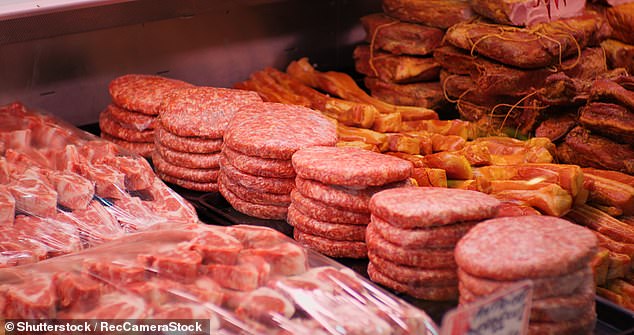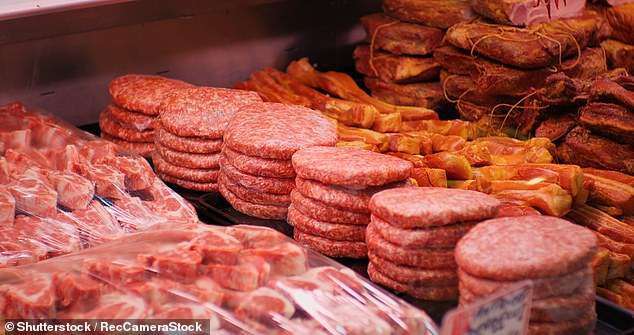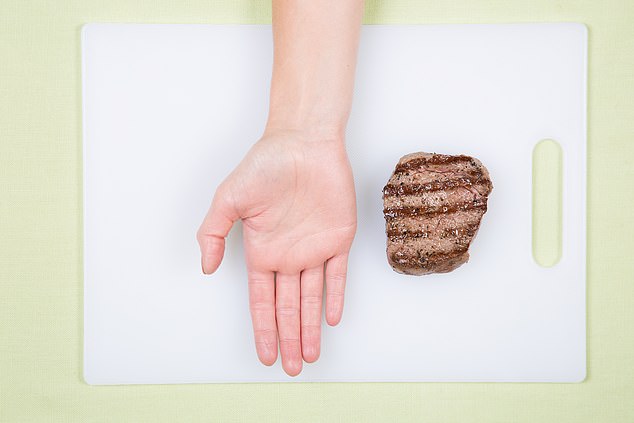Surprising Food That Causes Diabetes, Despite It Containing NO Sugar, According to Harvard Experts




It is sugar-free, unprocessed and comes from an animal.
According to top scientists from Harvard, eating red meat may increase the risk of developing type 2 diabetes.
Eating 70 grams of beef per day, roughly equivalent to one In-N-Out burger, was associated with a 26 percent higher risk of being diagnosed.
The researchers behind the new paper assured DailyMail.com that all other diet and lifestyle factors had been taken into account (type 2 diabetes is normally associated with a diet high in sugar, low in fibre, junk food and a sedentary lifestyle).

New research suggests that people who eat a diet high in animal meat may be at higher risk of developing diabetes

This is a serving of beef of about 100 grams, or 3.5 ounces, compared to the size of a hand. The people in the study who were most at risk of developing diabetes ate less beef than that per day, about 2.5 ounces
According to a study of more than 200,000 adults over the age of 36, the problem is heme iron, a type of iron found in meat and dairy products.
They suggest that heme iron causes inflammation in your body, which makes your body less responsive to insulin, a hormone that regulates blood sugar levels, and together these two factors can increase your risk of developing type 2 diabetes.
These findings suggest that eating a plant-based diet may help protect against developing diabetes, study author Dr. Frank Hu, Fredrick J. Stare Professor of Nutrition and Epidemiology at Harvard, told Dailymail.com.
“Reducing heme iron intake, particularly from red meat, and switching to a more plant-based diet may be effective strategies to reduce diabetes risk,” Dr. Hu said.
This is critical given how prevalent type 2 diabetes is in the United States. In 2021, 38 million adults in the U.S. had diabetes, According to the CDC.
That’s about 14 percent of the population.
The condition causes problems with processing sugar and regulating energy. If left untreated, diabetes can cause serious problems, such as nerve damage, heart disease and stroke.
Type 1 diabetes is usually caused by an autoimmune disease. Type 2 diabetes, on the other hand, is often caused by lifestyle choices, such as eating a lot of sugar and not exercising.
Most people who want to avoid diabetes are told to avoid sugar at all costs. But meat is not usually taken off the menu.
Animal meat is increasingly being seen as a contributing factor to a range of health problems, including cancer, despite being rich in protein and nutrients such as B vitamins.
Dietitians are well aware of these concerns, Michelle Routhenstein, a preventive cardiology dietitian and founder of Entirely Nourished who was not involved in the study, told DailyMail.com.
“We want to reduce our consumption of red meat,” she said, but added that it is crucial for those who eat less animal meat to get enough protein and iron from other sources.
It is found in leafy greens such as kale, but also in legumes and nuts.

Heme iron may worsen inflammation and make the body less sensitive to insulin, the researchers said, both of which can contribute to an increased risk of diabetes.
Research also increasingly shows that animal meat is linked to diabetes.
In this study, which was published in the journal Nature MetabolismHarvard researchers focused on one component of animal meat that they thought might account for this association: heme iron.
This is a type of iron that comes from hemoglobin, the chemical in the blood that helps the body move oxygen. Most animal products contain it, but in varying amounts.
Beef and lamb are particularly high in this nutrient.
In this case, the researchers divided the 204,600 participants into five groups based on their iron intake from animals, plants and supplements.
They also took into account factors such as race, body weight, exercise, sugar intake, fat intake, smoking, blood pressure, family history, and more.
“Therefore, it is unlikely that the results are influenced by other dietary choices,” study author Fenglei Wang, a research associate in the Department of Nutrition at the Harvard TH Chan School of Public Health, told DailyMail.com
People who got the most heme iron, about 1.5 mg per day, and who ate roughly 75 grams of beef or 85 grams of lamb, were 26 percent more likely to develop diabetes than people who got the least heme iron.
A typical serving of beef is about three ounces, an In-N-Out burger with one patty contains about two ounces of beef. If you eat one Big Mac, which contains just over three ounces of beef, per day, you will exceed that limit.
The group at highest risk of developing diabetes ate the equivalent of five Big Macs per week.
Because previous studies had found a similar link, Wang said their findings were “not very surprising.”
Researchers aren’t sure what might explain the link between heme iron and type 2 diabetes. But Mr. Wang said people who consume a lot of heme iron also show signs of insulin resistance and inflammation in their blood.
When the body becomes resistant to insulin, it can no longer process blood sugar as effectively. This can lead to sugar building up in the bloodstream and diabetes developing.
Inflammation can also cause diabetes by putting stress on the pancreas or other digestive organs, making it harder for the body to process sugar.
IF YOU HAVE A HEALTH STORY, WE’D LOVE TO HEAR IT. CONTACT HEALTH@DAILYMAIL.COM




